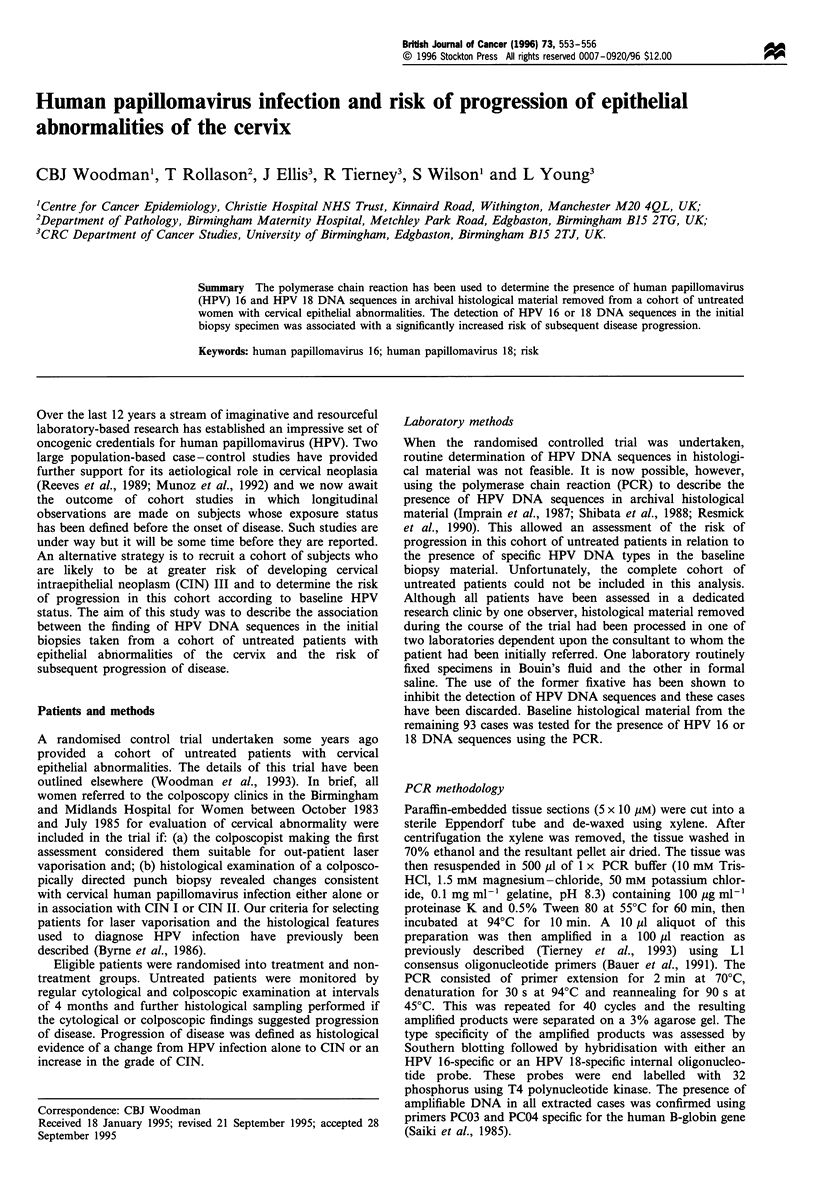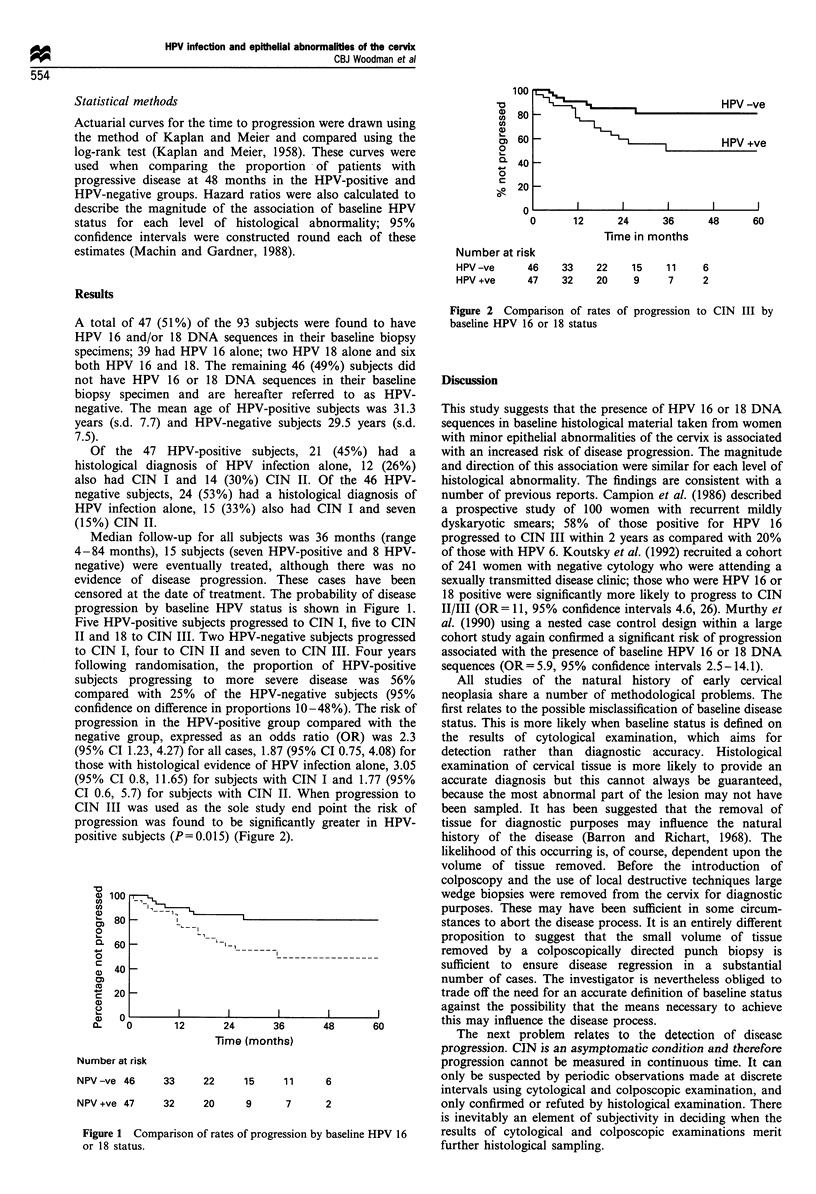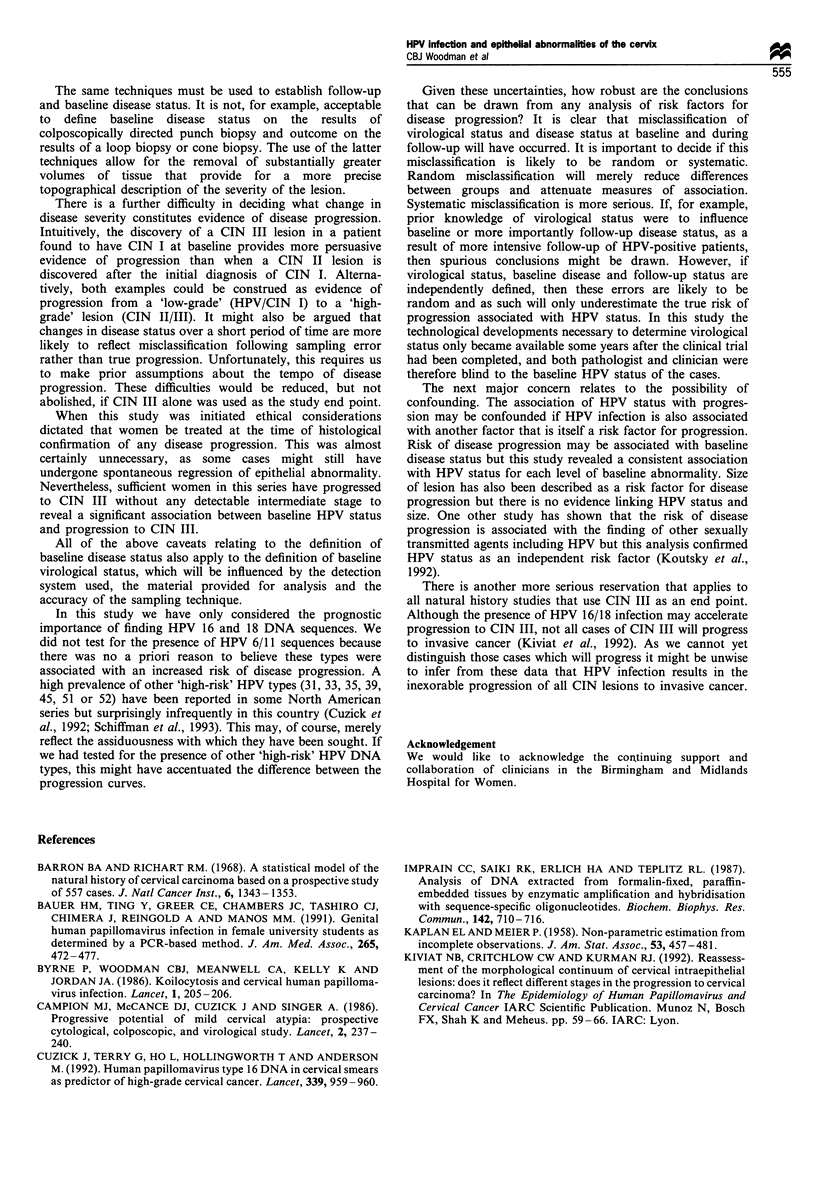Abstract
The polymerase chain reaction has been used to determine the presence of human papillomavirus (HPV) 16 and HPV 18 DNA sequences in archival histological material removed from a cohort of untreated women with cervical epithelial abnormalities. The detection of HPV 16 or HPV 18 DNA sequences in the initial biopsy specimen was associated with a significantly increased risk of subsequent disease progression.
Full text
PDF



Selected References
These references are in PubMed. This may not be the complete list of references from this article.
- Barron B. A., Richart R. M. A statistical model of the natural history of cervical carcinoma based on a prospective study of 557 cases. J Natl Cancer Inst. 1968 Dec;41(6):1343–1353. [PubMed] [Google Scholar]
- Bauer H. M., Ting Y., Greer C. E., Chambers J. C., Tashiro C. J., Chimera J., Reingold A., Manos M. M. Genital human papillomavirus infection in female university students as determined by a PCR-based method. JAMA. 1991 Jan 23;265(4):472–477. [PubMed] [Google Scholar]
- Byrne P., Woodman C., Meanwell C., Kelley K., Jordan J. Koilocytes and cervical human papillomavirus infection. Lancet. 1986 Jan 25;1(8474):205–206. doi: 10.1016/s0140-6736(86)90669-0. [DOI] [PubMed] [Google Scholar]
- Campion M. J., McCance D. J., Cuzick J., Singer A. Progressive potential of mild cervical atypia: prospective cytological, colposcopic, and virological study. Lancet. 1986 Aug 2;2(8501):237–240. doi: 10.1016/s0140-6736(86)92067-2. [DOI] [PubMed] [Google Scholar]
- Cuzick J., Terry G., Ho L., Hollingworth T., Anderson M. Human papillomavirus type 16 in cervical smears as predictor of high-grade cervical intraepithelial neoplasia [corrected]. Lancet. 1992 Apr 18;339(8799):959–960. doi: 10.1016/0140-6736(92)91532-d. [DOI] [PubMed] [Google Scholar]
- Impraim C. C., Saiki R. K., Erlich H. A., Teplitz R. L. Analysis of DNA extracted from formalin-fixed, paraffin-embedded tissues by enzymatic amplification and hybridization with sequence-specific oligonucleotides. Biochem Biophys Res Commun. 1987 Feb 13;142(3):710–716. doi: 10.1016/0006-291x(87)91472-0. [DOI] [PubMed] [Google Scholar]
- Kiviat N. B., Critchlow C. W., Kurman R. J. Reassessment of the morphological continuum of cervical intraepithelial lesions: does it reflect different stages in the progression to cervical carcinoma? IARC Sci Publ. 1992;(119):59–66. [PubMed] [Google Scholar]
- Koutsky L. A., Holmes K. K., Critchlow C. W., Stevens C. E., Paavonen J., Beckmann A. M., DeRouen T. A., Galloway D. A., Vernon D., Kiviat N. B. A cohort study of the risk of cervical intraepithelial neoplasia grade 2 or 3 in relation to papillomavirus infection. N Engl J Med. 1992 Oct 29;327(18):1272–1278. doi: 10.1056/NEJM199210293271804. [DOI] [PubMed] [Google Scholar]
- Machin D., Gardner M. J. Calculating confidence intervals for survival time analyses. Br Med J (Clin Res Ed) 1988 May 14;296(6633):1369–1371. doi: 10.1136/bmj.296.6633.1369. [DOI] [PMC free article] [PubMed] [Google Scholar]
- Min J., Arganoza M. T., Ohrnberger J., Xu C., Akins R. A. Alternative methods of preparing whole-cell DNA from fungi for dot-blot, restriction analysis, and colony filter hybridization. Anal Biochem. 1995 Feb 10;225(1):94–100. doi: 10.1006/abio.1995.1113. [DOI] [PubMed] [Google Scholar]
- Murthy N. S., Sehgal A., Satyanarayana L., Das D. K., Singh V., Das B. C., Gupta M. M., Mitra A. B., Luthra U. K. Risk factors related to biological behaviour of precancerous lesions of the uterine cervix. Br J Cancer. 1990 May;61(5):732–736. doi: 10.1038/bjc.1990.164. [DOI] [PMC free article] [PubMed] [Google Scholar]
- Reeves W. C., Brinton L. A., García M., Brenes M. M., Herrero R., Gaitán E., Tenorio F., de Britton R. C., Rawls W. E. Human papillomavirus infection and cervical cancer in Latin America. N Engl J Med. 1989 Jun 1;320(22):1437–1441. doi: 10.1056/NEJM198906013202201. [DOI] [PubMed] [Google Scholar]
- Resnick R. M., Cornelissen M. T., Wright D. K., Eichinger G. H., Fox H. S., ter Schegget J., Manos M. M. Detection and typing of human papillomavirus in archival cervical cancer specimens by DNA amplification with consensus primers. J Natl Cancer Inst. 1990 Sep 19;82(18):1477–1484. doi: 10.1093/jnci/82.18.1477. [DOI] [PubMed] [Google Scholar]
- Saiki R. K., Scharf S., Faloona F., Mullis K. B., Horn G. T., Erlich H. A., Arnheim N. Enzymatic amplification of beta-globin genomic sequences and restriction site analysis for diagnosis of sickle cell anemia. Science. 1985 Dec 20;230(4732):1350–1354. doi: 10.1126/science.2999980. [DOI] [PubMed] [Google Scholar]
- Schiffman M. H., Bauer H. M., Hoover R. N., Glass A. G., Cadell D. M., Rush B. B., Scott D. R., Sherman M. E., Kurman R. J., Wacholder S. Epidemiologic evidence showing that human papillomavirus infection causes most cervical intraepithelial neoplasia. J Natl Cancer Inst. 1993 Jun 16;85(12):958–964. doi: 10.1093/jnci/85.12.958. [DOI] [PubMed] [Google Scholar]
- Shibata D. K., Arnheim N., Martin W. J. Detection of human papilloma virus in paraffin-embedded tissue using the polymerase chain reaction. J Exp Med. 1988 Jan 1;167(1):225–230. doi: 10.1084/jem.167.1.225. [DOI] [PMC free article] [PubMed] [Google Scholar]
- Woodman C. B., Byrne P., Kelly K. A., Hilton C. A randomized trial of laser vaporization in the management of cervical intraepithelial neoplasia associated with human papilloma virus infection. J Public Health Med. 1993 Dec;15(4):327–331. doi: 10.1093/oxfordjournals.pubmed.a042884. [DOI] [PubMed] [Google Scholar]


